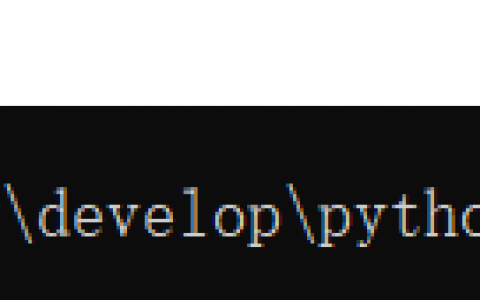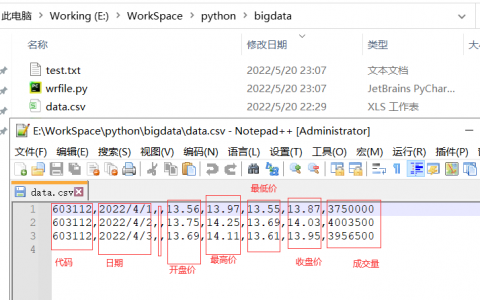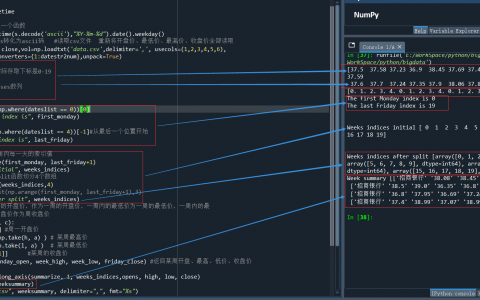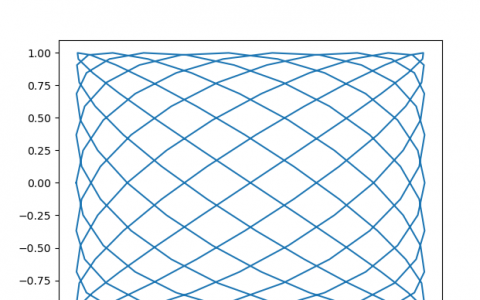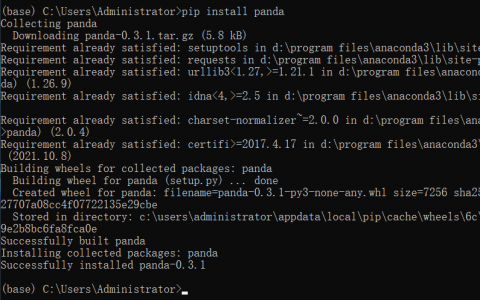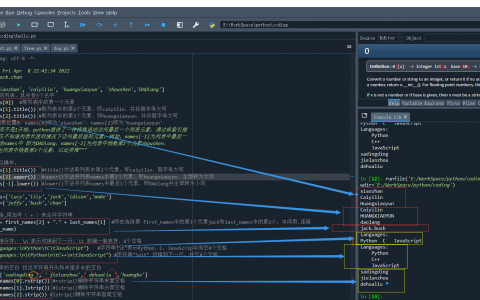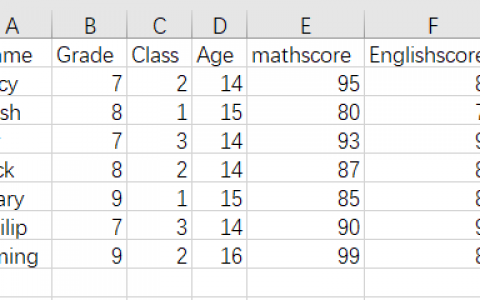成交量(volume)是投资中一个非常重要的变量,它是指在某一时段内具体的交易数,可以在分时图中绘制,包括日线图、周线图、月线图甚至是5分钟、30分钟、60分钟图中绘制。
股票市场成交量的变化反映了资金进出市场的情况,成交量是判断市场走势的重要指标。一般情况下,成交量大且价格上涨的股票,趋势向好。成交量持续低迷时,一般出现在熊市或股票整理阶段,市场交易不活跃。成交量是判断股票走势的重要依据,对分析主力行为提供了重要的依据。投资者对成交量异常波动的股票应当密切关注。
OBV(On-Balance Volume,净额成交量或叫能量潮指标)是最简单的股价指标之一,它可以由当日收盘价、前一天的收盘价以及当日成交量计算得出。以前一日为基期计算当日的OBV值(可以认为基期的OBV值为0)。若当日收盘价高于前一日收盘价,则本日OBV等于基期OBV加上日成交量。若当日收盘价低于前一日收盘价,则本日OBV等于基期OBV减去当日成交量。若当日收盘价相比前一日没有变化,则当日成交量以0计算。
一、OBV计算
鉴于上述计算方法,需要在成交量前面乘上一个由收盘价变化决定的正负号(收盘价低于前一交易日收盘价,负号,收盘价高于前一交易日收盘价,正号)。在本篇中,学习该问题的两种解决方法,一种是使用NumPy中的 sign 函数,另一种是使用NumPy的piecewise 函数。
1) 把数据分别加载到收盘价和成交量的数组中:
close,vol = np.loadtxt('data036.csv',delimiter=',', usecols=(5,6),converters={1:datestr2num},unpack=True)
data036.csv中的第6列和第7列分别为收盘价和当日成交量。
前篇介绍过numpy.diff()可以计算相邻的差(即上述收盘价close的差值),并利用这个差值, 用sign 函数计算正负号
changes = np.diff(close) signs = np.sign(changes) print ("Signs", signs)
运行结果:
Signs [-1. -1. -1. -1. 1. 1. 1. -1. 1. 1. 1. -1. 1. -1. -1. -1. -1. 1. 1. -1. -1. 1. 1. 1. 1. 1. 1. 1. -1. 1. 1. 1. -1. -1. -1. 1. -1. 1. 1. 1. -1. -1. 1. 1. 1. -1. -1. 1. 1. 1. 1. 1. 1. -1....
2)也可以使用 piecewise 函数来获取数组元素的正负。 piecewise函数可以分段给定取值。使用合适的返回值和对应的条件调用该函数:
pieces = np.piecewise(changes, [changes < 0, changes > 0], [-1, 1]) print("Pieces", pieces)
3)判断是否 sign 函数和piecewise 函数计算结果是否一致用array_equal()函数:
print ("Arrays equal?", np.array_equal(signs, pieces))
运行结果:
Arrays equal? True
4)由于diff()y计算的结果是相邻数据相减,因此得到419个数据,较从文件中导入的数据420个少一位,因此无法计算首日的OBV值
obv_values = vol[1:] * signs #计算obv值 print("obv values:",obv_values[:20]) #打印前20个obv值
完成代码如下:
import numpy as np from datetime import datetime import matplotlib.pyplot as plt import sys,os def datestr2num(s): #定义一个函数 return datetime.strptime(s.decode('ascii'),"%Y-%m-%d").date().weekday() close,vol = np.loadtxt('data036.csv',delimiter=',', usecols=(5,6),converters={1:datestr2num},unpack=True) #new_close = np.loadtxt('data999.csv',delimiter=',', usecols=(5,),converters={1:datestr2num},unpack=True) changes = np.diff(close) signs = np.sign(changes) print ("Signs", signs[:20])#打印前20个signs值 pieces = np.piecewise(changes, [changes < 0, changes > 0], [-1, 1]) print("Pieces", pieces[:20])#打印前20个pieces值 print ("Arrays equal?", np.array_equal(signs, pieces)) obv_values = vol[1:] * signs #计算obv值 print("obv values:",obv_values[:20]) #打印前20个obv值
运行结果:

二、 计算单个交易日的利润
1)读入数据
将所有交易数据(开盘价、收盘价、最高价、最低价,成交量等)加载到对应的数组中
import numpy as np from datetime import datetime import matplotlib.pyplot as plt import sys,os def datestr2num(s): #定义一个函数 return datetime.strptime(s.decode('ascii'),"%Y-%m-%d").date().weekday() opens,highs,lows,closes,vols = np.loadtxt('data036.csv',delimiter=',', usecols=(2,3,4,5,6),converters={1:datestr2num},unpack=True) #开盘价、最高价、最低价、收盘价、成交量数组。
2)调用 vectorize 函数并给定calc_profit 函数作为参数:
(1)先定义一个计算利润的函数:这个函数,是以开盘价买入,以当日收盘价卖出,所获得的利润即买入和卖出的差价。事实上,计算相对利润更为直观。
def calc_profit(opens, highs, lows, closes): buy = opens * 1 if lows < buy < highs : return (closes - buy)/buy else: return 0
(2)调用 vectorize 函数并给定calc_profit 函数作为参数
func = np.vectorize(calc_profit) profits=func(opens,highs,lows,closes) print ("Profits", profits)
3)选择非零利润的交易日,并计算平均值:
real_trades = profits[profits != 0] print ("Number of trades", len(real_trades), round(100.0 * len(real_trades)/len(closes), 2),"%") print ("Average profit/loss %", round(np.mean(real_trades) * 100, 2))
当然也可以分别计算盈利和亏损:
real_trades = profits[profits > 0] print ("Number of trades", len(real_trades), round(100.0 * len(real_trades)/len(closes), 2),"%") print ("平均盈利: %", round(np.mean(real_trades) * 100, 2)) loss_trades = profits[profits < 0] print ("Number of trades", len(loss_trades), round(100.0 * len(loss_trades)/len(closes), 2),"%") print ("平均亏损 %", round(np.mean(loss_trades) * 100, 2))
实际运行结果:

三、数据平滑
噪声数据很难处理,因此需要对其进行平滑处理,除前篇介绍的计算移动平均线的方法,还可以使用NumPy中的一个函数来平滑数据。hanning 函数是一个加权余弦的窗函数。
1)调用 hanning 函数计算权重,生成一个长度为 N 的窗口(在这个示例中 N 取8)
N=8 weights = np.hanning(N) #调用hanning 函数计算权重,生成一个长度为8的窗口 print("Weights", weights)
运行结果:
Weights [0. 0.1882551 0.61126047 0.95048443 0.95048443 0.61126047 0.1882551 0. ]
2)用 convolve 函数计算closes的股票收益率,以归一化处理后的 weights 作为参数
closes_returns = np.diff(closes) / closes[ : -1] #计算收盘价相邻差价
smooth_closes = np.convolve(weights/weights.sum(), closes_returns) [N-1:-N+1]#利用权重,计算数据平滑
opens_returns = np.diff(opens) / opens[ : -1] #计算开盘价相邻差价
smooth_opens = np.convolve(weights/weights.sum(), opens_returns) [N-1:-N+1]
3)用 Matplotlib 绘图
t = np.arange(N - 1, len(closes_returns))
plt.plot(t, closes_returns[N-1:], lw=1.0)
plt.plot(t, smooth_closes, lw=2.0)
plt.plot(t, opens_returns[N-1:], lw=1.0)
plt.plot(t, smooth_opens, lw=2.0)
plt.show()
运行结果:

4)
如上图中的折线有交叉,这些交叉点可能就是股价趋势的转折点,至少可以表明closes和opens之间的股价关系发生了变化,这些转折点可能会经常出现,可以利用它们预测未来的股价走势。
使用多项式拟合平滑后两组数据,解出的两个多项式取值相等时(即在哪些地方存在交叉点),这等价于先对两个多项式函数作差,然后对所得的多项式函数求根。使用 polysub 函数对多项式作差如下:
t = np.arange(N - 1, len(closes_returns)) poly_closes = np.polyfit(t, smooth_closes,N) #求收盘价的多项式 poly_opens = np.polyfit(t, smooth_opens, N) #求收盘价的多项式 poly_sub = np.polysub(poly_closes, poly_opens) #polysub函数对多项式作差, xpoints = np.roots(poly_sub) #对所得的多项式函数求根 print("Intersection points:", xpoints)
运行结果:
Intersection points: [403.82451866 354.50031142 289.94335284 213.44012464 185.82581983 97.72837787 51.03724424 18.28586259]
5)用 isreal 函数来判断数组元素是否为实数,用 select 函数选出它们。 select 函数可根据一组给定的条件,从一组元素中挑选出符合条件的元素并返回数组。
得到的实数交叉点、再去掉其中为0的元素。 trim_zeros 函数可以去掉一维数组中开头和末尾为0的元素。
reals = np.isreal(xpoints) #用isreal 函数来判断数组元素是否为实数 print ("Real number:", reals) xpoints = np.select([reals], [xpoints]) #select 函数根据一组给定条件, xpoints = xpoints.real # 从一组元素中挑选出符合条件的元素并返回数组 print("Real intersection points:", xpoints) print("Sans 0s:", np.trim_zeros(xpoints))#trim_zeros 函数可以去掉一维数组中开头和末尾为0的元素
运行结果如下:
Intersection points: [403.82451866 354.50031142 289.94335284 213.44012464 185.82581983 97.72837787 51.03724424 18.28586259] Real number: [ True True True True True True True True] Real intersection points: [403.82451866 354.50031142 289.94335284 213.44012464 185.82581983 97.72837787 51.03724424 18.28586259] Sans 0s: [403.82451866 354.50031142 289.94335284 213.44012464 185.82581983 97.72837787 51.03724424 18.28586259]
完整代码如下:
import numpy as np from datetime import datetime import matplotlib.pyplot as plt def datestr2num(s): #定义一个函数 return datetime.strptime(s.decode('ascii'),"%Y-%m-%d").date().weekday() opens,highs,lows,closes,vols = np.loadtxt('data036.csv',delimiter=',', usecols=(2,3,4,5,6),converters={1:datestr2num},unpack=True) #开盘价、最高价、最低价、收盘价、成交量数组。 N=8 weights = np.hanning(N) #调用hanning 函数计算权重,生成一个长度为8的窗口 print("Weights:", weights) closes_returns = np.diff(closes) / closes[ : -1] #计算收盘价相邻差价 smooth_closes = np.convolve(weights/weights.sum(), closes_returns) [N-1:-N+1]#利用权重,计算数据平滑 opens_returns = np.diff(opens) / opens[ : -1] #计算开盘价相邻差价 smooth_opens = np.convolve(weights/weights.sum(), opens_returns) [N-1:-N+1] t = np.arange(N - 1, len(closes_returns)) #多项式拟合平滑后的数据 t = np.arange(N - 1, len(closes_returns)) poly_closes = np.polyfit(t, smooth_closes,N) #求收盘价的多项式 poly_opens = np.polyfit(t, smooth_opens, N) #求收盘价的多项式 poly_sub = np.polysub(poly_closes, poly_opens) #polysub函数对多项式作差, xpoints = np.roots(poly_sub) #对所得的多项式函数求根 print("Intersection points:", xpoints) reals = np.isreal(xpoints) #用isreal 函数来判断数组元素是否为实数 print ("Real number:", reals) xpoints = np.select([reals], [xpoints]) #select 函数根据一组给定条件, xpoints = xpoints.real # 从一组元素中挑选出符合条件的元素并返回数组 print("Real intersection points:", xpoints) print("Sans 0s:", np.trim_zeros(xpoints))#trim_zeros 函数可以去掉一维数组中开头和末尾为0的元素 plt.plot(t, closes_returns[N-1:], lw=1.0) plt.plot(t, smooth_closes, lw=2.0) plt.plot(t, opens_returns[N-1:], lw=1.0) plt.plot(t, smooth_opens, lw=2.0) plt.show()

本站文章如无特殊说明,均为本站原创,如若转载,请注明出处:Python数据分析–Numpy常用函数介绍(6)–Numpy中与股票成交量有关的计算 - Python技术站

 微信扫一扫
微信扫一扫  支付宝扫一扫
支付宝扫一扫 